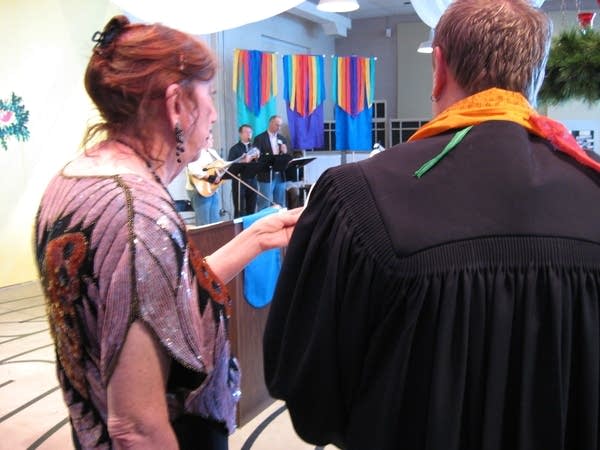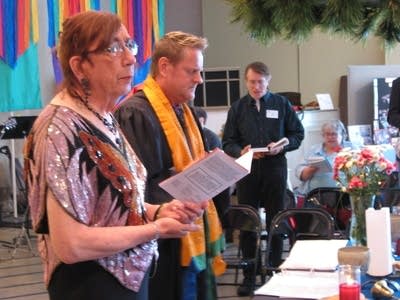Navigating the space between genders
Go Deeper.
Create an account or log in to save stories.
Like this?
Thanks for liking this story! We have added it to a list of your favorite stories.

When Barbara Satin first started going out as a woman, it wasn't just different, it was dangerous.
"I knew that I had this inner secret," Satin, who was born as a man, recalls. "Which was that I'm transgender. And if anyone found out, all the good things in my life would just disappear; they'd be shattered."

Back then, being transgender was thought of as perverse. She worried it could cost her her job, her relationship with her family, even her safety.
At the time, Barbara was part of a social club for transgender women. They would meet to talk and trade tips on makeup and clothing.
Turn Up Your Support
MPR News helps you turn down the noise and build shared understanding. Turn up your support for this public resource and keep trusted journalism accessible to all.
But they had to keep it secret.
The meetings were never advertised. They'd hear about them through word of mouth. The locations weren't announced until the day of the event.
"We even went as far as having a sergeant at arms who stood at the door to make sure you were a legitimate member. If you weren't, you weren't allowed in the room," explains Satin.
Sounds like something from the communist witch hunts of the 1950s. But actually it was the early '90s.
[image]
Today, things look a little different.
Ryan Li Dahlstrom leads me on a tour of a teen center in Minneapolis called District 202.
"It's an LGBTQ youth center," says Dahlstrom.
LGTBQ stands for Lesbian, Gay, Bisexual, Transgender, Queer or Questioning teens. Basically, District 202 is a safe space for anyone who doesn't fit your typical gender roles.
"This is a spot for them to meet people -- to hang out, to get involved in programs," explains Dahlstrom as he shows off the lounge area.
This place is sort of a response to the negative climate Barbara Satin grew up in. It's part coffee house, part rec room and part dance club.
Ryan Li Dahlstrom works here as a youth advocate. He's like a big brother to these teens [and I use the word "brother" lightly.]

That's because Dahlstrom is also trangender. But it's kind of hard to tell which way he's going. He comes off as either a tomboy girl or a really effeminate guy.
"When I tell people I'm trans, they'll be like, are you transitioning to be a man or a woman?" says Dahlstrom. "I'm like, 'That's a really great question. I'm just me.'"
Dahlstrom says he likes occupying this space somewhere between male and female. He hopes that by blurring the lines between the two he can show others that gender is not as hard and fast as most people think.
But he runs into problems, like which bathroom to use.
"I had one woman say to me, 'What are you doing here? This is the women's bathroom!' Holding their children as if I'm some kind of freak who could harm them," Dahlstrom remembers.
He has gotten similar responses in the men's room. Neither one is really the right fit. The same issue pops up in changing rooms, gym showers, or on applications where you have to check male or female.
We just all are so ingrained. We're taught somehow that we are just supposed to fit into box a or b, m or f."
"I think that we just all are so ingrained," says Max Gries. "We're taught somehow that we are just supposed to fit into box a or b, m or f."
Gries works with an organization at the University of Minnesota called the Transgender Commission. Their job is to promote an inclusive environment for all genders. Part of that involves creating more spaces on campus where people who don't identify as male or female can feel comfortable.
That could mean having gender-free bathrooms, locker rooms or even gender-free dorms.
This may sound extreme. After all, for most of the population, gender identity is black and white. But for those people in the middle, navigating around the gender binary is next to impossible.
"All of our systems depend on that gender identity for some reason or another," explains Gries. "And we just place a huge importance on it."
Systems like your driver's license, Social Security, hospital forms -- the list goes on.
In fact, there really isn't even a proper pronoun that doesn't have sex attached to it. Some linguists say we could use words like the German "sie," which can be genderless. Or "herm," a combination of him and her. In reality, though these terms have yet to enter the common vocabulary.

The problem isn't that people who defy gender are just different. It's that we don't really even have a mental category for them.
So how do you go about opening up a space in people's minds for a new definition of gender? For one thing, you start by spreading the word.
That's what Barbara Satin does every Sunday morning. She's no longer hiding. In fact, she makes a point of being seen as a trans woman. She helps lead services at her local church and she's active in her community.
On this day, she's standing in front of the congregation in a flashy sequined butterfly top, with a long black skirt and boots. It's all part of her campaign.
"If people have no other impression of me, I want them to say, 'Wow, she, or he -- hopefully she -- looks really neat,'" says Satin.
"But I also want them to go past that and say, maybe I could ask her about this because I don't really understand it."
Satin says she doesn't think there will come a day in her lifetime when transgender people will find a perfect fit in society. But she says, as long as there is continued progress, she can live with that.




